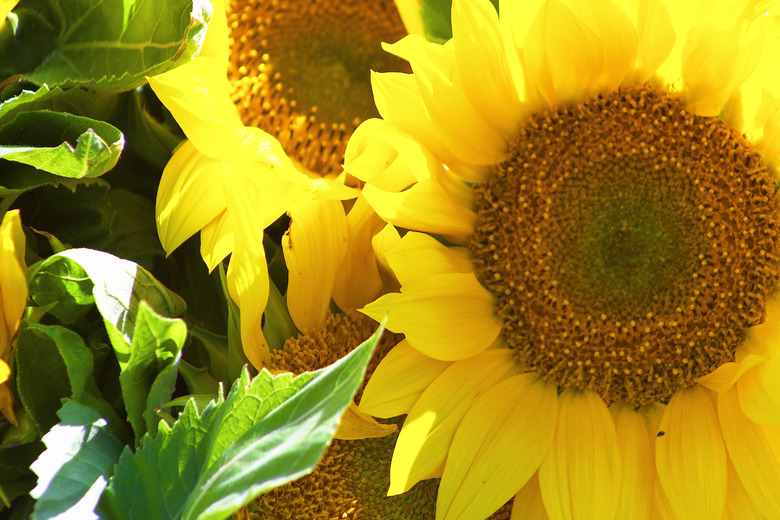Can You Transplant Sunflowers?
We may receive a commission on purchases made from links.
The bright flowers of the sunflower (Helianthus spp.) brighten gardens and roadsides across North America. While the giant, seed-forming blossoms are found on the annual species (Helianthus annuus), gardeners also grow perennial sunflowers in U.S. Department of Agriculture plant hardiness zones 3 through 10. Sunflowers are usually planted in the garden, although you can start the seeds indoors and transplant sunflowers outside when the weather warms.
Tip
Sunflowers can be transplanted with care. Avoid damaging the tap root.
Annual and Perennial Sunflowers
Annual and Perennial Sunflowers
Annual sunflowers range from 12 inches to 15 feet tall, or more, with yellow to red flowers. While the taller cultivars, like 'American Giant,' 'Cyclops' and 'Mammoth Russian,' feature blossoms that may reach 12 inches across and giant seed heads full of tasty sunflower seeds (a treat for birds, wildlife and humans), the small and mid-sized cultivars are grown for their decorative impact. At 18 to 24 inches tall, 'Starburst Aura' features yellow double blooms with shaggy petals, while 'Choco Sun' and 'Elf' dwarf sunflowers grow between 10 and 14 inches tall, perfect for a container garden in a sunny courtyard.
The perennial species also have a place in the garden. The 8-foot-tall Maximilian sunflower (Helianthus maximiliani), hardy in USDA zone 4 through 9, produces 2- to 3-inch yellow flowers from midsummer through fall. If ocean spray affects your garden, the salt-tolerant swamp sunflower (Helianthus angustifolius), also known as narrow-leaved sunflower, fills USDA zone 5 through 9 flowerbeds with 2- to 3-inch-wide yellow flowers from late summer until frost. Also hardy in USDA zones 5 through 9, the cultivar 'Happy Days' produces double yellow flowers with golden fluffy centers on 24-inch-tall bushes.
Sow Sunflower Seeds
Sow Sunflower Seeds
After all chance of frost has passed, put on your safety goggles, gloves and a mask to prepare a sunny, well-drained garden bed by digging in 2 to 4 inches of compost, manure and other amendments as needed. Sunflowers prefer a slightly acidic soil, with a pH level of 6.0 to 6.8. Sow the seeds 1 inch deep and 6 inches to 2 feet apart, depending on the mature size of the species and cultivar.
Alternatively, sow sunflower seeds indoors in paper or peat biodegradable pots four to six weeks before the last frost date. Fill the pots with sterile seed-starting mix and moisten before sowing the seeds 1 inch deep. Keep in a warm, brightly lit location until the seeds germinate, in seven to 10 days.
Transplant Sunflowers Into the Garden
Transplant Sunflowers Into the Garden
When the weather is warm and all chance of frost has passed, dig holes in the garden bed, deep enough to accommodate the biodegradable pots. Tear away the upper portion of the pot so no part of it shows above ground; the exposed pot will wick water away from the sunflower's roots. Plant the sunflower at the same depth it's growing in the pot, and water thoroughly. Add a stake for the tall cultivars so the weight of the flowers and seed heads doesn't bend or break the stems.
You can also plant the smaller annual and perennial cultivars in planters or half wine barrels. Fill with an all-purpose potting mix that drains well, or mix your own using equal parts compost, peat moss or coconut coir, and coarse sand. Place your container garden in full sun and monitor the soil moisture closely; containers dry out quickly in the hot summer sun.
Care for Sunflowers
Care for Sunflowers
Water sunflowers when the top of the soil and the first 1 to 2 inches are dry. Use a soaker hose or hose-end bubbler to avoid wetting the foliage. A 3- to 4-inch layer of organic mulch pulled back 3 to 4 inches from the stems will slow evaporation from the soil and discourage weed growth. Remove weed seedlings as soon as they appear.
Fertilize when the sunflowers have developed several true leaves or after transplanting into the garden. Side-dress with a slow-release balanced fertilizer according to the label directions, and scratch it lightly into the soil around the sunflower plants. Water thoroughly after fertilizing.
